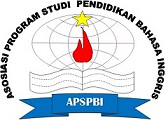A CASE STUDY OF SELF-DIRECTED LEARNING USING MOVIE TO PROMOTE ORAL COMMUNICATION
Abstract
Keywords
Full Text:
PDFReferences
Al-ahdal, A. A., Alfallaj, F., Al-awaied, S., & Al-hattami, A. (2014). A comparative study of proficiency in speaking and writing among EFL learners in Saudi Arabia. American International Journal of Contemporary Research, 4(2), 141–149.
Aydın, B. (2001). A study of sources of foreign language classroom anxiety in speaking and writing classes. (Dissertation). Eskişehir, Turkey: Anadolu University.
Bal-Gezegina, B. (2014). An investigation of using video vs. audio for teaching vocabulary. Procedia - Social and Behavioral Sciences, 143, 450–457. https://doi.org/10.1016/j.sbspro.2014.07.516
Benson, P. (2001). Teaching and researching autonomy in language learning. Essex, England. Pearson Education Ltd.
Benson, P. (2011). Language learning and teaching beyond the classroom: An introduction to the field. In P. Benson & H. Reinders (Eds.), Beyond the language classroom (pp. 7-16). New York: Palgrave Macmillan.
Berk, R. A. (2009). Multimedia teaching with video clips: TV, movies, YouTube, and mtvU in the college classroom. International Journal of Technology in Teaching and Learning, 5(1), 1–21. Retrieved from http://www.sicet.org/journals/ijttl/issue0901/1_Berk.pdf
Bozatlı, I. (2003). Academic oral presentation skills instructors' perceptions of the final project presentation rating scale used in the modern languages department at Middle East Technical University. (Thesis). Ankara, Turkey: Bilkent University.
Bozorgian, H. (2012). The relationship between listening and other language skills in international English language testing system. Theory and Practice in Language Studie, 2(4), 657–663. https://doi.org/10.4304/tpls.2.4.657-663
Bygate, M. (2009). Teaching the spoken foreign language. In B. Seidlhofer& K. Knapp (Eds.), Teaching the spoken foreign language (pp.401-438). Berlin, Germany: Mouton de Gruyter.
Cheng, C. J. (2005). The relationship of foreign language anxiety of oral performance achievement, teacher characteristics and in-class activities. (Thesis). Taipei City: Ming Chuan University.
Christianson, M., Hoskins, C., & Watanabe, A. (2009). Evaluating the effectiveness of a video-recording based self-assessment system for academic speaking. Language Research Bulletin, 24, 1-15. Retrieved from http://web.icu.ac.jp/lrb/docs/Christianson-Hoskins-Watanabe.pdf
Cooke, S. D. (2013). Examining transcription, autonomy and reflective practice in language development. RELC Journal, 44(1), 75-85.
DeSaint-Leger, D., 2009. Self-assessment of speaking skills and participation in a foreign language class. Foreign Language Annals, 42, 158-178.
Fathali, S., & Okada, T. (2016). A self-determination theory approach to technology-enhanced out-of-class language learning intention: A case of Japanese EFL learners. International Journal of Research Studies in Language Learning, 6(4), 53-64.
Feng, Z. (2007). The perceptions of Chinese junior high and senior high students regarding the teaching and learning of English listening and speaking skills. (Dissertation). Lubbock, TX: Texas Tech University.
Göktürk, N. (2016). Examining the effectiveness of digital video recordings on oral performance of EFL learners. Teaching English with Technology, 16(2), 71-96.
Harker, M. (2004). The linguistic proficiency of Korean English teachers: An investigation of self-assessment procedures and self-directed learning tasks using video. Retrieved from https://books.google.com.my/books?id=OAZeHQAACAAJ
Hsu, H. Y., Wang, S. K., &Comac, L. (2008). Using audio blogs to assist English-language learning: An investigation into student perception. Computer Assisted Language Learning, 21(2), 181-198.
Kim, H. S. (2015). Using authentic videos to improve efl students’ listening comprehension. International Journal of Contents, 11(4), 32-44.
Luoma, S. (2004). Assessing speaking. Cambridge, England: Cambridge University Press.
Lynch, T. (2007). Learning from the transcripts of an oral communication task. ELT Journal, 61(4), 311-320.
Lynch, T. (2001). Seeing what they meant: Transcribing as a route to noticing. ELT Journal, 55(2), 124-132.
Mathew, N. G., &Alidmat, A. O. H. (2013). A study on the usefulness of audio-visual aids in EFL classroom: Implications for effective instruction. International Journal of Higher Education, 2(2), 86–92. http://doi.org/10.5430/ijhe.v2n2p86
Mennim, P. (2003). Rehearsed oral L2 output and reactive focus on form. ELT Journal, 57(2), 130-138.
Mennim, P. (2012). Learner negotiation of L2 form in transcription exercises. ELT Journal, 66(1), 52-61.
Nunan, D. (2003). Listening in a second language. The Language Teacher, Retrieved from http://www.jaltpublications.org/old_tlt/articles/2003/07/nunan
O’Malley, J. M., &Pierce, L. V. (1996). Authentic assessment for English language learners: Practical approaches for teachers. New York, NY: Addison-Wesley.
Pop, A., Tomuletiu, E. A., & David, D. (2011). EFL speaking communication with asynchronous voice tools for adult students. Procedia Social and Behavioral Sciences, 15, 1199-1203.
Potosi, L. J., Loaiza, E. A., & Garcia, A. C. (n.d.). Using video materials as a teaching strategy for listening comprehension. Universidad Tecnologica de Pereira Facultad. Retrieved from repositorio.utp.edu.co/dspace/bitstream/handle/11059/1936/371333A786.pdf
Richards, J. C. (2015). The changing face of language learning: Learning beyond the classroom. RELC Journal, 46(1), 5-22. http://dx.doi.org/10.1177/0033688214561621
Rismawati. (2017). Teaching listening by using authentic videos. English Education Journal, 8(2), 222-233.
Steve, M. (2018). Listening comprehension: An important language skill. The Linguist Institute, Inc. Retrieved from: https://blog.thelinguist.com/listening-comprehension
Wilson, S. T. J. (2006). Anxiety in learning English as foreign language: Its associations with student variables, with oral proficiency, and with performance on an oral test. (Dissertation). Granada: Universidad de Granada.
Williams, Z. (2014). The use of multimedia material in teaching Chinese as a second language and pedagogical implications. Retrieved from https://scholarworks.umass.edu/theses/1016
Woottipong, K. (2014). Effect of using video materials in the teaching of listening skills for university students. International Journal of Linguistics, 6(4). https://doi.org/10.5296/ijl.v6i4.5870
DOI: http://dx.doi.org/10.20527/jetall.v2i1.7372
Article Metrics
Abstract view : 2384 timesPDF - 1049 times
Refbacks
- There are currently no refbacks.
This journal is indexed in:


This Journal is listed in:
 Journal of English Teaching, Applied Linguistics and Literatures (JETALL)
Journal of English Teaching, Applied Linguistics and Literatures (JETALL)








.png)



1.png)
